23 Ecommerce Optimization Tips to Greatly Increase Conversion Rates
I hope you enjoy this blog post. If you want Hello Bar to grow your leads, click here.
Author:
Andrei Gonzales
Published
August 2, 2024

Ecommerce optimization is essential for any business owner who wants to stand out and get found amidst the Amazons and eBays of the world. A small online store can perform very well, but you have to know how to make your site discoverable and compelling.
That happens via ecommerce optimization. From product images and explainer videos to product copy and checkout process, every detail can help or hurt your chances of converting a prospect. That’s what we’re going to cover today.
This post will describe ecommerce optimization, explain conversion rates, and help you calculate your own conversion rate. Next, we’ll discuss 23 helpful tips to maximize conversions on your ecommerce website.
What is Optimization in Ecommerce?
The term “ecommerce optimization” refers to the process of preparing your website to attract and retain, visitors. In other words, it’s a way to get people to your ecommerce store and convince them to convert.
The ecommerce optimization process can involve lead generation, lead magnets, exit popups, incentives, calls to action, and more. If you make your ecommerce store irresistible, people won’t be able to look away.
More importantly, you have to showcase your unique selling position (USP) so your visitors aren’t tempted to look elsewhere.
What is a Good Ecommerce Conversion Rate?
Ecommerce conversion rates vary by industry, device, and other factors. According to research published by Statista, the general apparel industry had the highest conversion rate, at 2% in the first quarter of 2024. The luxury handbag niche had the least, at 0.3%
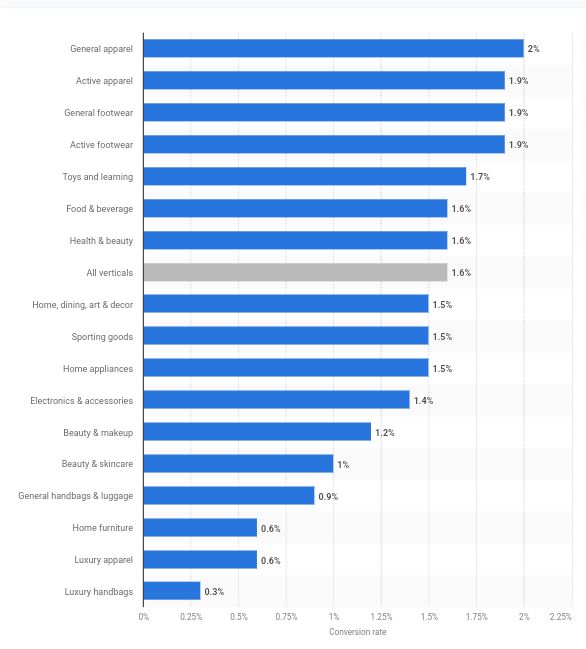
Several factors may be responsible if your ecommerce conversions are below the industry average. It could be that your checkout page has multiple form fields or doesn’t support various payment processors.
Also, an ecommerce website that’s slow, difficult to navigate, or not optimized for mobile users can cause online shoppers to drop off the conversion funnel. Finally, customers seek reassurance that your product is authentic. However, site visitors may leave without purchasing if there’s no customer review on your product pages.
You May Also Like:
- 11 Benefits of Conversion Rate Optimization and Best Practices
- Optimize Your Site: 12 Things to Delete Right Now
Understanding Different Ecommerce Conversion Rate Metrics
Conversions can happen in several scenarios. Obviously, the most common metric to measure is sales. However, you need to dig a little deeper than that.
For instance, an ecommerce marketplace can trace customers’ buying journeys with Google Analytics. Are they coming from your main traffic acquisition channels? How many touchpoints do they make before they buy?
You also need to know which metrics influence conversions. Here are some metrics to look out for:
- Time on Page: This is the amount of time visitors spend on a specific page of your ecommerce website, especially product pages and checkout pages.
- Website Speed: It helps you know the time it takes your web pages to load.
- Traffic: This refers to the number of visitors to your ecommerce website over a given period, whether from paid ads, referrals, or organic traffic.
- Cart Abandonment Rate: It highlights the percentage of users who added items to their cart but didn’t complete the purchase.
- Average Order Value: This is the average amount spent per order, highlighting the effectiveness of your pricing strategy.
Why Are Conversion Rates Important for Ecommerce?
The goal of ecommerce optimization is to increase sales, right? Web traffic, for instance, is great for vanity, but it doesn’t put food on the table.
Sales do.
Knowing your conversion rate lets you see what you’re doing right and where you can improve. From there, you can implement ecommerce optimization strategies and other tactics to increase conversion rates and close more sales. This includes using a multilingual ecommerce platform to reach wider audiences and offering free shipping to first-time customers.
If you have a low conversion rate and a high bounce rate, it’s either because your copy is too confusing or your site does not load fast enough. In such situations, your conversion rate might increase if you reduce the bounce rate.
However, the only way to reach these conclusions is to track your conversions.

Divide your total ecommerce transactions by your total site visits, then multiply the resulting number by 100.
For instance, you have 1,000 site visits and 100 transactions. That gives you a 10 percent conversion rate (100/1,000*100).
You May Also Like:
- How To Optimize Your Marketing Strategy Using Data From Hello Bar
- Website Conversion Optimization: How to Get Results With A/B Testing (& Actual Examples To Get You Started)
List of 23 Ecommerce Optimization Best Practices to Increase Conversion Rates
Now that we’ve covered some of the basics of ecommerce optimization, let’s turn our attention to how it looks in a real-life marketing strategy. What can you do to optimize conversion rates and increase your sales?
1. Use a Good Cart Abandonment Software Program
Ecommerce website optimization often comes down to tracking data and implementing automation. Those two facets come together to help you know your audience better.
Cart abandonment software helps reduce cart abandonment rates and bring back people who might have left your site for any reason.
For instance, let’s say a visitor packs a cart full of products at your ecommerce store. Then, they abandon the cart halfway through the checkout process.
That person then receives an email: “You forgot your stuff! It’s still here for you.” Something like that.
Now, the consumer has another opportunity to return to the cart and complete checkout.
People abandon carts for different reasons. They might have an urgent meeting to attend or get irritated by the number of form fields they have to fill out. Bringing them back can boost conversion rates.
2. Offer Free Shipping to Increase Ecommerce Conversion Rates
One of the top objections to ordering online is paying for shipping. Since shipping costs often amount to half or more of a small purchase price, driving to a local store makes more sense.
You can refute that objection by offering free shipping. It’s a simple way to boost conversions and generate more revenue.
Just add an exit popup or a top bar that lets your visitors know about your free shipping offer. That way, there’s no doubt they’ll see it.
You May Also Like:
- 18 Fantastic Abandoned Cart Email Tips to Increase Your Conversions
- 29 Best Abandoned Cart Email Examples: Increase Sales Today
3. Prioritize Ecommerce Website Optimization for Mobile Devices
Responsive design is essential for any website, particularly for ecommerce marketplace. You need to provide attractive, useful information to consumers no matter what device they use.
Ensure your integrated software works on mobile. With Hello Bar, for instance, you can create a special bar just for mobile visitors.
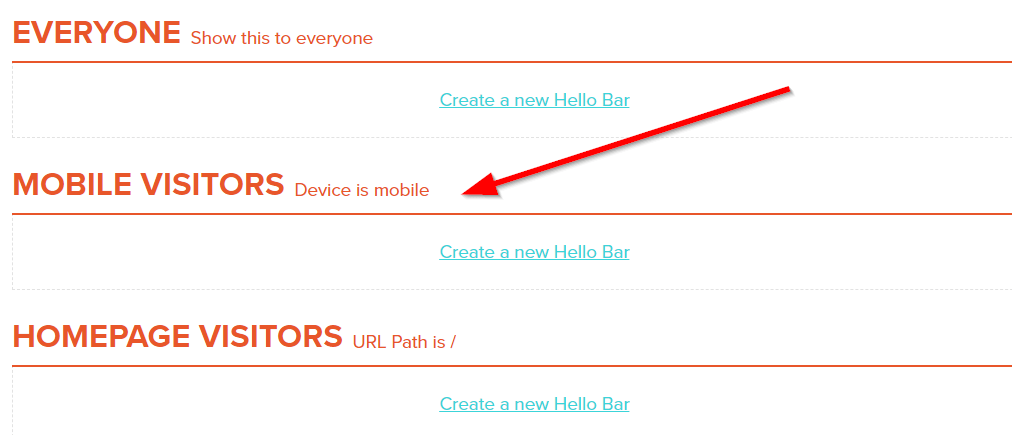
4. Try These Ecommerce Checkout Conversion Rate Optimization Tips
Use as few form fields as possible to speed up checkout.
Use a two-page checkout to minimize the appearance of effort needed to complete the process.
Add more payment options, such as PayPal.
Allow guests the option to checkout instead of forcing signups.
These tips will encourage people to complete the checkout process rather than abandon their carts.
5. Set Up Your Ecommerce Website Structure For Conversion
Site structure matters when it comes to ecommerce optimization. A confusing navigation system, lack of breadcrumbs, and poor categorization are among the most common pitfalls.
Keep it as simple as possible. Set up product categories, assign products to them, and make sure customers can see their breadcrumb trail.
For instance, you always know where you are in the Amazon hierarchy:

The same should be true on your site. Additionally, make sure you have a robust search feature.
6. Use Exit-Intent Popups to Increase Conversions
An exit-intent popup gives your prospect one more chance to buy your product. It effectively says, “Wait, are you sure you want to go? Let me sweeten the pot.”
You can create exit popups with Hello Bar to invite your readers to stay. Offer a coupon code or other incentive to make a purchase.
Overstock.com has created an ingenious exit popup that shows this when you try to leave a particular page.
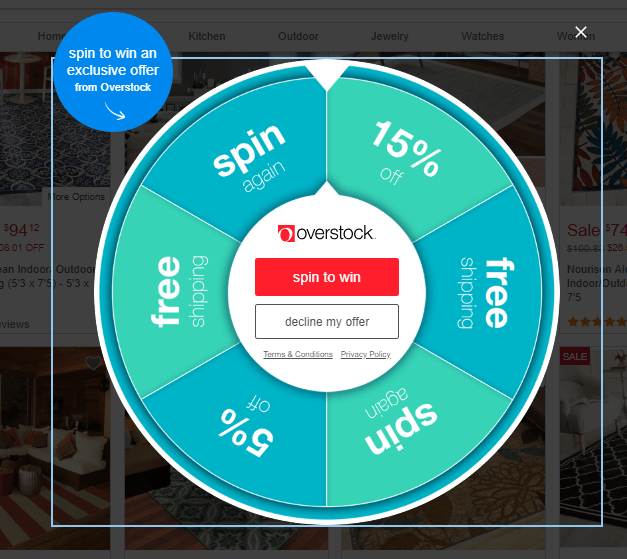
It’s a “spin to win.”
When we did the spin, it landed on 15 percent off. Overstock presented this screen:
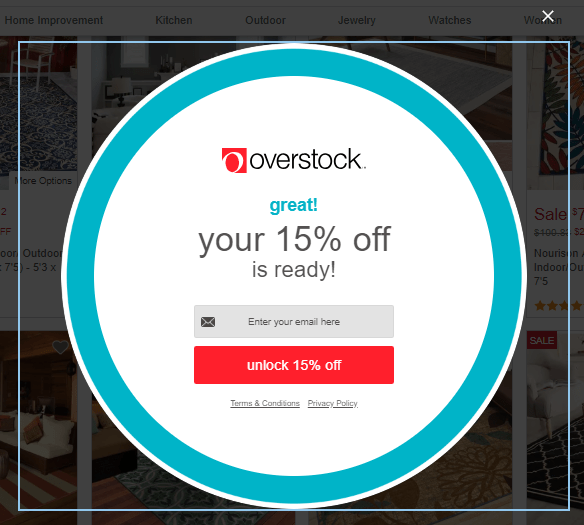
Even if you don’t want to buy something now, you can retain the offer by entering your email address. Notice the unusual and effective CTA: “Unlock 15% off.”
7. Make CTA Buttons Prevalent to Increase Ecommerce Conversions
Speaking of CTAs, you need good ones if you want your ecommerce optimization process to yield results. Your CTA buttons should inspire and delight your audience.
Ideally, you’ll want to use unusual language. The Overstock example illustrates this perfectly: “Unlock 15% off.” It’s creative and authoritative.
You don’t want to assume that a CTA button will work. Ensure you A/B test your CTAs frequently to see which ones prove more persuasive to your audience.
Hello Bar allows you to automatically A/B test your CTAs. Once the software has gathered sufficient data, it will let you know which version “won.”
You May Also Like:
- Ways to Use Calls to Action (CTAs) in Your Marketing Strategy
- Different Kinds of CTAs and How to Use Them Effectively
8. Let Customers Check Out As Guests To Reduce Abandoned Checkouts And Improve Ecommerce Optimization
We touched on this briefly earlier, but it deserves special attention.
When you require customers to sign up as site members before they can buy something, you put extra hurdles in their way. Now, they have to confirm their email addresses, fill out more form fields, and spend more time.
Plus, you’re asking for information that isn’t strictly necessary for the transaction. That’s why the GDPR exists. Consumers want more control over how, why, and when their personal information gets collected.
Allow prospects to buy as guests. You’ll improve your conversion rates considerably.
9. Use High-Quality Product Images to Increase Ecommerce Optimization
Images sell the product. So do videos.
Part of ecommerce optimization revolves around giving your prospect every excuse to buy. A detailed description can help, but there’s no substitute for visual evaluation.
You don’t need an expensive setup to take good photos and videos. Check out Etsy for great examples of product photography done on the cheap.

10. Ask Customers for Product Reviews to Increase Ecommerce Social Proof
Social proof is essential for ecommerce optimization. If you want people to buy, you need to show them that other people have bought — and loved — your product.
Consider adding a request for an honest review to your confirmation email. Provide a link back to the product page and, if necessary, detailed instructions for posting a review.
Some customers won’t even read the reviews. They’ll simply see that your product has a decent star rating and several reviews.
11. Use Simple Forms to Increase Ecommerce Conversion Rates
Nobody wants to fill out a 100-field form. If you ask for too much information, you take up more of the prospect’s time and request more of their personal information.
Ideally, ask for only the minimum information needed to complete the transaction. You’ll want a name and an email address, as well, so you can follow up.
12. Show Shopping Cart Contents At All Time
Page design can also help improve ecommerce optimization. If you always show the amount of items in the shopping cart, you constantly remind the consumer to check out.
Amazon does this.
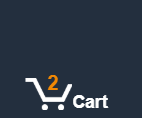
It’s a great visual cue for the consumer so they don’t leave the website without carrying out the purchase. Remember that people are easily distracted.
13. Openly Show Phone Number and Contact Page to Shoppers
When people shop for specific products, they might have questions. If you don’t provide an easy way for those people to get their questions answered, you might lose the sale.
Include your company’s phone number at the top of every page. Make it big and bold so consumers can’t miss it. In fact, you might want to use a Hello Bar for this. Let your mobile customers call you directly from the top bar.
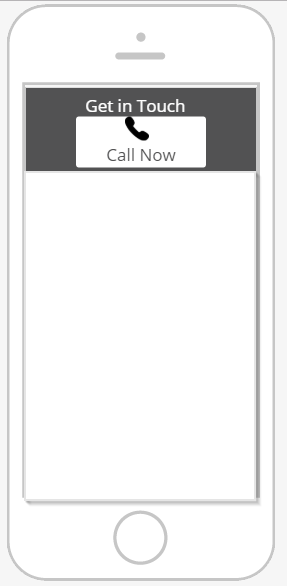
Additionally, add a link to your “contact” page in the navigation bar. Your prospects might prefer to contact you via email or another communication method.
14. Provide Detailed Product Descriptions to Increase Ecommerce Conversion Rates
Potential customers want to understand exactly what they’re buying. So, include all relevant product details like materials, dimensions, and features in bullet points.
Your product descriptions should also explain what makes your product stand out. Addressing common customer queries within the description also increases conversion rates.
You May Also Like:
- Ecommerce Marketing: 32 Tips To Skyrocket Sales
- Customer Journey Maps – A Complete Guide to Help You Create Yours
15. Use Trust Badges to Let Your Customers Know Your Store is Safe
Everybody wants to feel safe, right? Even while they’re browsing the web — and especially when they’re paying for products on the Internet.
Trust badges convey that you value your customers’ privacy and security and actively help secure their information.
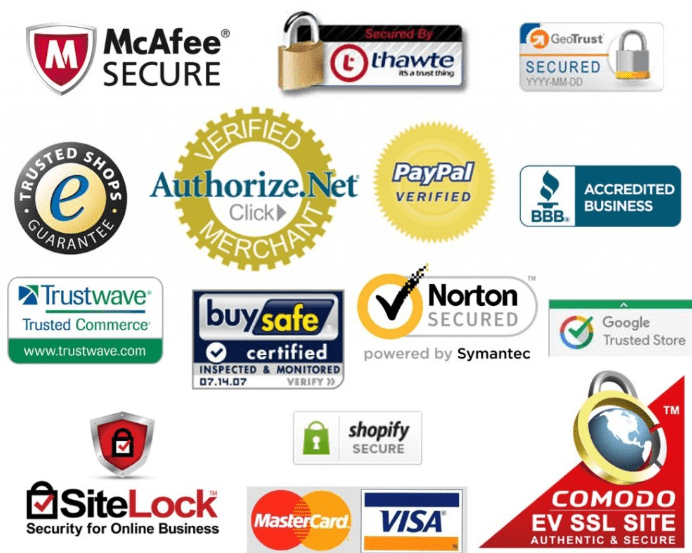
You don’t have to include every trust badge or safety seal available. However, you want the bare minimum, at least, to show you care about security.
16. Create An Impressive About Us Page To Increase Website Trust
People appreciate authenticity. Yes, that word has become slightly overused in marketing, but it still matters.
Think about your own web browsing activities. What do you look for when you discover you’re interested in a company or site? Probably the “about us” page.
You want to know who’s behind the company, their location, vision, mission and services. A non-existent or empty about page sends a negative message. It says the company is hiding from something.
Add plenty of detail, personality, and color to your About page. Provide as many concrete facts as possible, such as your business’s physical location, toll-free phone number, and more.
Adding social proof, mission statements, and other details that give your company more substance is also a good idea.
17. Test Search Results To Find Potential Mistakes
Ideally, you want your ecommerce products to show up in search. If they don’t, you’re missing out on traffic — and sales.
A quick search for “Bluetooth headphones” on Google displays sponsored results first, then organic results.
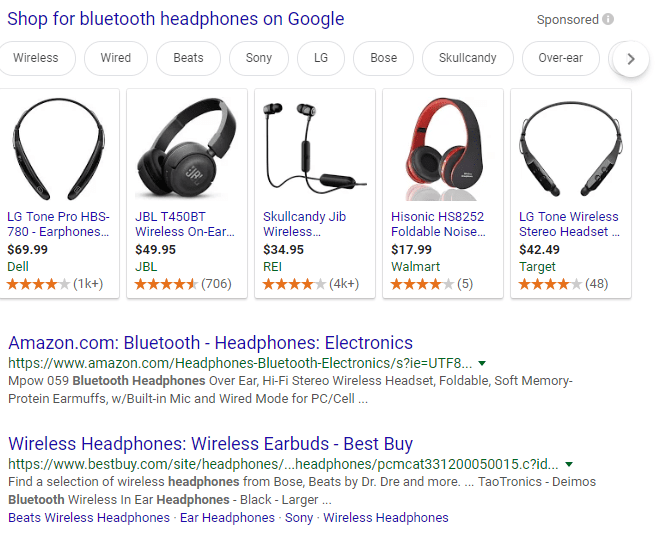
Bluetooth headphone sellers want to appear as close to the top of the organic search results as possible. If you’re not appearing there, check out the pages that do.
You can find many ways to optimize your product pages for search. You may need to mention more of the primary keyword or related keywords.
You May Also Like:
- Getting More Leads from Your Blog Traffic (Steps Included)
- SEO For Lead Generation: How To Skyrocket Organic Leads
18. Use Product Video Demonstrations to Increase Conversion Rates
Product videos and explainer videos can cause a massive increase in conversion rates. One of the downfalls of shopping online is that you can’t pick up the product and examine it.
Your prospects, however, can watch you do it.
Demonstrate your product’s most important qualities or features. Explain why it’s the best value and how your prospect can benefit from it.
Videos are also great for cross-promotion. Embed them in your blog posts, push them live on YouTube, and encourage others to embed them to increase website traffic and conversions.
19. Use Social Media Buttons to Increase Shoppers’ Engagement With Your Brand
Shoppers might visit your website and decide that your product isn’t for them. However, that doesn’t mean the shopper can’t provide value to your business.
Maybe that person knows someone else who would love your product. If you deploy social media buttons, they can share it with their audience on Facebook, Twitter, and other social platforms.
These buttons take the work out of sharing a page on social media. They automatically fill in the information, so your user simply has to tap or click a couple of times to spread the word.
20. Personalize Referral Traffic: Use Different Popups for Each Referrer to Increase the Ecommerce Conversion Rate
Hello Bar allows you to target your popups and bars to specific people based on how they land on your website. By specifying a rule for referral sources, you can customize your message.
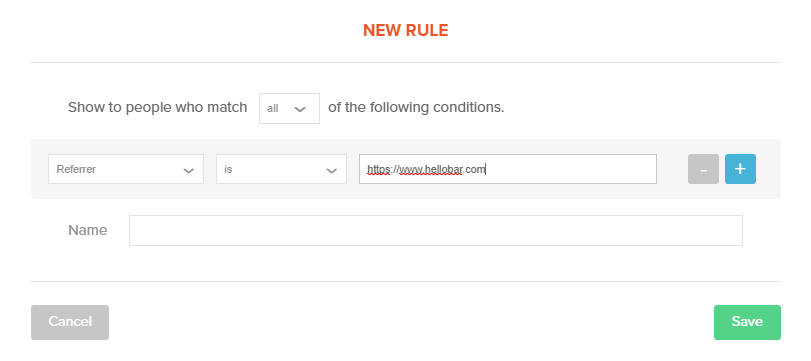
This way, you can optimize your ecommerce site for the individual visitor. For instance, you’ve just published a guest post on someone else’s blog. You could create a welcome message for everyone who comes from that domain.
You May Also Like:
- Best 43 Call-to-Action Phrases Proven To Increase Clicks and Leads
- How to Grow Your Email List: 21 Great Tips for 2024
21. Use Retargeting Ads
You don’t have to advertise if you lack the funds or your organic marketing efforts are not functioning correctly. However, retargeting ads can be particularly useful and profitable for ecommerce optimization.
It’s probably happened to you many times. You visit a website, look at a few products, and decide you’re not ready to buy. The next day, you hop on Facebook to check up on your pals, and there is an ad for the product you considered yesterday on your screen.
After giving it some thought, you say to yourself, “Yeah, actually, I do want that product.” Then you buy.
Retargeting ads can be more efficient than other ad forms because they create a new touch point with consumers who are already brand-aware.
22. Constantly Measure Your Ecommerce Optimization Results
It sounds labor-intensive, but it doesn’t have to be. Monitoring your ecommerce optimization results will tell you what’s working well and what isn’t so you can adjust accordingly.
For instance, if you run A/B tests through Hello Bar to see how your offers work, you’ll quickly know what offers and CTAs perform best with your audience. Similarly, you can track your traffic and conversions via Google Analytics, Crazy Egg, and other useful tools.
Even when you have a good conversion rate, don’t stop testing. There are always new strategies, copywriting approaches, and other ways to improve what’s on your website.
23. Prioritize Site Speed for Optimal User Experience
Users have little patience, and when they come across a slow-loading page, they quickly move on to the next great website. Thankfully, there are many options to help you optimize your ecommerce site’s speed.
Compress the size of your images without reducing the quality and discard all unnecessary code (HTML, CSS, JavaScript). Using a fast and reliable website hosting service provider that guarantees you fewer downtimes would also be helpful.
You May Also Like:
- Copywriting Tips: 23 Ultra Effective Steps to Increase Conversions
- 35 Lead Magnet Ideas and Examples to Convert Visitors Into Leads
FAQs
Q1. What role does user experience (UX) design play in ecommerce optimization?
Here’s an overview of the importance of user experience design in ecommerce optimization:
- UX design ensures customers find products easily, increasing the likelihood of purchases.
- It prioritizes important elements like CTAs, making them likely to be engaged with.
- UX considers factors like site speed optimization crucial for search engine ranking and retaining website visitors.
Q2. How can A/B testing be used to refine and improve ecommerce site performance?
A/B testing can refine and improve the performance of ecommerce websites in the following ways:
- It tests different CTAs, product pages, and the checkout flow, enabling ecommerce conversion rate optimization.
- It experiments with website designs and optimizes website speed to enhance mobile user experience.
- It evaluates the effectiveness of different pricing strategies to increase revenue.
Q.3 How can high-quality product images influence my ecommerce conversion rates?
High-quality images make your products more aesthetically appealing to your target audience. It also allows them to see the finest details of your products, enabling them to make informed buying decisions.
Q4. How to use SEO for ecommerce?
You can use search engine optimization for your ecommerce store in the following ways:
- Conduct keyword research and incorporate target keywords in product pages and meta descriptions.
- Connect related product categories and use descriptive file names and alt text for images.
- Publish engaging blog posts related to your products and encourage customer feedback.
Q5. How can I leverage customer reviews and testimonials to boost product credibility and sales?
Here are a few tips for boosting product credibility and sales using customer reviews and testimonials:
- Create a dedicated page on your ecommerce website to display reviews
- Encourage customers to share product reviews on social media
- Respond to reviews to show your commitment to customer satisfaction
Conclusion
Ecommerce optimization should be part of your everyday life as an ecommerce store owner. Conversion optimization helps you sell more products, cultivate brand loyalty, and gain more exposure.
Optimization in ecommerce refers to the steps you take to make your products and website more desirable to consumers. It also involves making your pages more discoverable via search engines.
Conversion rates are important because they tell you how well your products are performing. And no matter how high they get, they can always improve.
You can easily calculate your conversion rate by dividing your total transactions by your total site visits and multiplying by 100. Calculate each product page individually, too.
Next, put into practice the above 23 ecommerce optimization tips. From deploying cart abandonment software to optimizing the checkout process, you’ll thank yourself for putting in the extra effort.
Don’t forget that tools like Hello Bar can help. Use Hello Bar to keep people on the page, advertise offers, and reach out to people from specific referral sources.
How do you optimize your ecommerce store?






